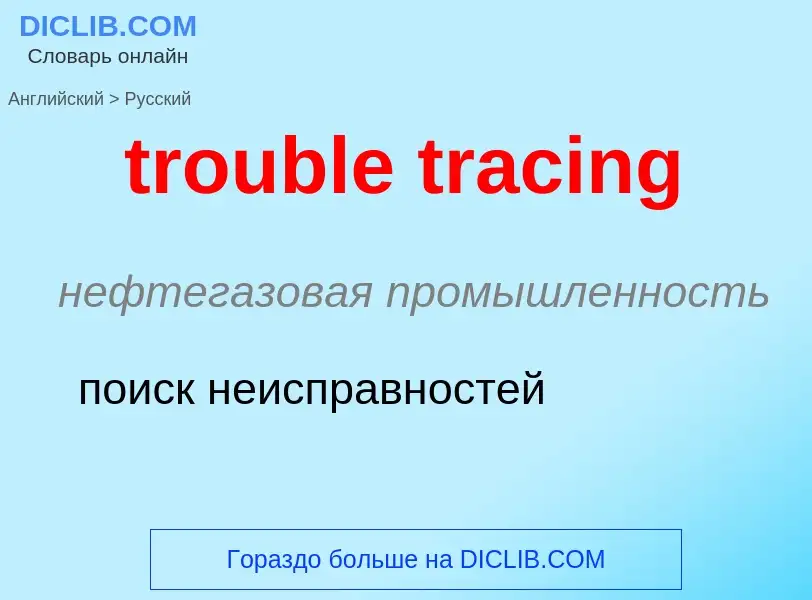Перевод и анализ слов искусственным интеллектом ChatGPT
На этой странице Вы можете получить подробный анализ слова или словосочетания, произведенный с помощью лучшей на сегодняшний день технологии искусственного интеллекта:
- как употребляется слово
- частота употребления
- используется оно чаще в устной или письменной речи
- варианты перевода слова
- примеры употребления (несколько фраз с переводом)
- этимология
trouble tracing - перевод на русский
нефтегазовая промышленность
поиск неисправностей
['trʌb(ə)l]
общая лексика
беспокойство
волнение
тревога
забота
болезнь
авария
нарушение режима
неуправка
перебой
труд
хлопоты
нефтегазовая промышленность
неисправность
повреждение
перебой (в работе)
нарушение (нормального режима работы)
существительное
['trʌb(ə)l]
общая лексика
беспокойство
волнение
тревога
неприятность
беда
горе
напасть
скандал
неприятности
затруднение
трудность
заботы
хлопоты
труд
усилие
помеха
источник неприятностей
причина беспокойства
недостаток
изъян
волнения
беспорядки
(the trouble) волнения
волна насилия в Ольстере
болезнь
недуг
беспокойство, волнение
заботы, хлопоты
неприятности, горе, беда
волнения, беспорядки
аварийный
диалектизм
роды
техника
нарушение (правильного хода работы)
авария
повреждение
неисправность
неполадки
нарушение правильности хода или действия
геология
сброс
дислокация
синоним
глагол
общая лексика
тревожить
волновать
расстраивать
тревожиться
волноваться
расстраиваться
беспокоить
мучить
причинять боль
страдания
затруднять
приставать
надоедать
просить об одолжении
даваться с трудом
(обыкн. в отриц. предложениях) стараться
трудиться
делать усилия
беспокоить(ся), тревожить(ся)
приставать, надоедать
(в отриц. предложениях) трудиться, стараться
(преим. тех.) нарушать, повреждать
техника
нарушать
повреждать
редкое выражение
будоражить
баламутить
синоним
2) неисправность; повреждение; авария; перебой (в работе); нарушение (производственного процесса) || нарушать (правильный ход работы)
- capacity troubles
- labor troubles
Википедия

Path-tracing is a computer graphics Monte Carlo method of rendering images of three-dimensional scenes such that the global illumination is faithful to reality. Fundamentally, the algorithm is integrating over all the illuminance arriving to a single point on the surface of an object. This illuminance is then reduced by a surface-reflectance function (BRDF) to determine how much of it will go toward the viewpoint-camera. This integration-procedure is repeated for every pixel in the output-image. When combined with physically-accurate models of surfaces, accurate models of real light-sources, and optically-correct cameras, path-tracing can produce still images that are indistinguishable from photographs.
Path-tracing naturally simulates many effects that have to be specifically-added to other methods (conventional ray-tracing or scanline rendering), such as soft shadows, depth of field, motion blur, caustics, ambient occlusion, and indirect lighting. Implementation of a renderer including these effects is correspondingly simpler. An extended version of the algorithm is realized by volumetric path tracing, which considers the light scattering of a scene.
Due to its accuracy, unbiased nature, and algorithmic simplicity, path tracing is used to generate reference images when testing the quality of other rendering algorithms. However, the path tracing algorithm is relatively inefficient: A very large number of rays must be traced to get high-quality images free of noise artifacts. Several variants have been introduced which are more efficient than the original algorithm for many scenes, including bidirectional path tracing, volumetric path tracing, and Metropolis light transport.



